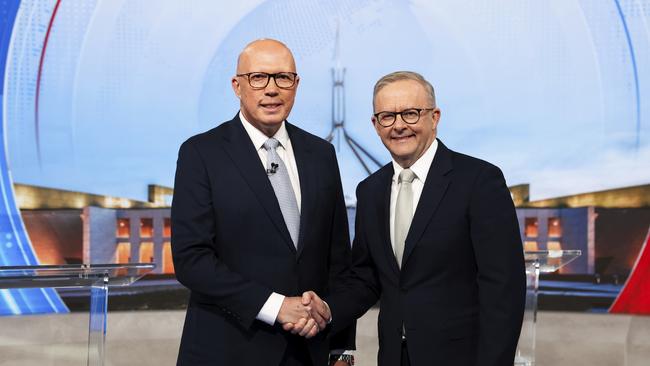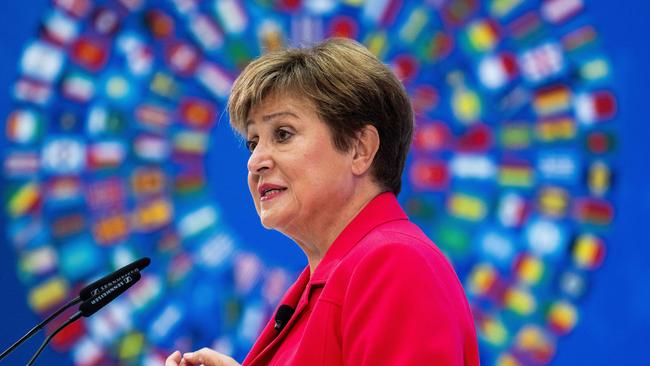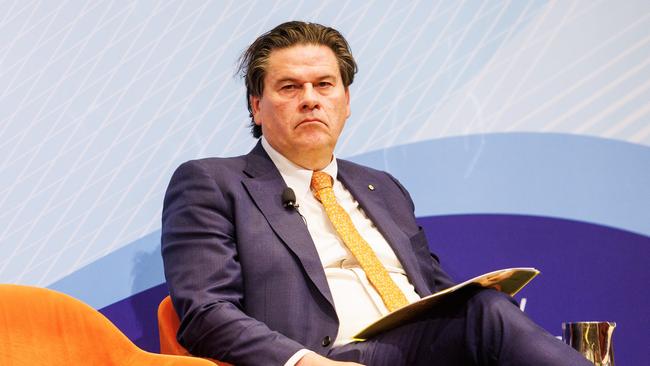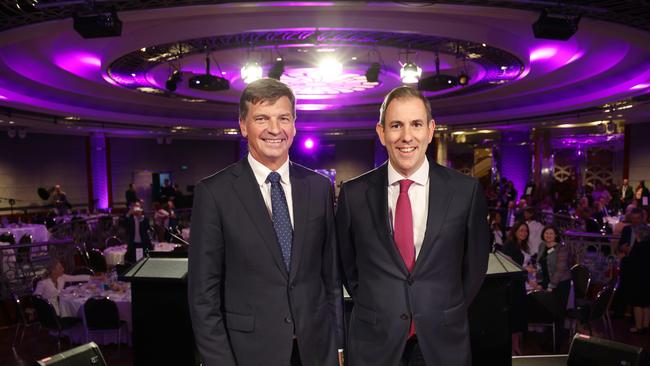Policy complacency threatens our prosperity in Trump’s dangerous new world
Anthony Albanese and Peter Dutton are smugly ignoring the prime economic challenges in Donald Trump’s new world disorder.

In the third leaders’ debate the other night, Anthony Albanese was asked to nominate the biggest threat to Australia right now. “Complacency,” the Prime Minister shot back. “And the uncertain world we inherit.”
The Labor leader, clawing ahead in the published polls, may have been reminding himself not to get ahead of himself. But then 10,000 hours of talking point practice kicked in and he shifted the focus to Peter Dutton, reminding viewers of his central allegation: the Opposition Leader posed a risk to amity in the region and that now was not a time for regime change in this country.
Yet the evidence of the policy offerings, such as they are, in this campaign suggests the major parties reek of self-satisfaction. Policy blind spots abound, yet what voters are served up is a tweak here, a few billion here and there, and Bob’s your uncle.
It’s de rigueur in these set pieces to declare “Australia is the greatest country”; to suggest there may be deep-seated problems, mismanagement or peril invites the charge of “talking Australia down”, as Albanese accused his opponent when Dutton floated the R-word in their Nine Network encounter.
Lest this be seen as gratuitous cheer, we’re not in grave danger of tumbling into recession.
But we’re not match fit to take on the big economic policy challenges on the horizon: fixing the budget and tax system, growing the economy and lifting productivity (again, the only way to sustainably raise material living standards).
The pre-election economic and fiscal outlook was virtually a carbon copy of the March 25 budget, save for an update on the risks from Donald Trump’s trade provocations and the slyest of warnings about the likely course of future income gains. “If productivity growth does not pick up as expected, this would pose a downside risk to wage growth,” the PEFO said.
But it’s this week’s grim assessment from the International Monetary Fund that provides a reality check amid the suspended animation of campaign promises and rhetoric: America’s abrupt increase in tariffs to a centennial high and attendant uncertainty will significantly slow global growth.

The Washington-based body cut its growth forecasts to 2.8 per cent this year and 3 per cent next year, a cumulative downgrade of 0.8 percentage points from three months ago, while inflation is expected to rise slightly. Given the dense nature of today’s supply chains and communion of economies, the dip in international trade will be greater than the drop in output.
“The global economic system under which most countries have operated for the last 80 years is being reset, ushering the world into a new era,” IMF chief economist Pierre-Olivier Gourinchas says. Australia’s GDP growth for 2025 has been clipped to 1.6 per cent (from 2.1 per cent in the IMF’s October 2024 estimate).
Treasury’s forecast in March was 2.25 per cent growth this calendar year and next. The nation can’t escape the slow-growth rut.
Neither of the major parties is prepared to confront this most basic of performance failures. It’s complacency bleeding into neglect of duty.
Despite the most rapid rise on record in the size of our population, Inquirer estimates the economy will be 3 per cent smaller by year’s end than its pre-pandemic growth trajectory.
By comparison, US output is likely to be 4 per cent larger (based on the latest IMF forecasts); China’s GDP is estimated to be 5 per cent smaller than its pre-pandemic growth path.
The Covid-19 shock shrank our economy by 2 per cent in 2020. But GDP bounced back across the next two years, as restrictions were eased and the border reopened to foreigners, recovering the lost ground to resume the pre-crisis growth track.
The Reserve Bank’s monetary squeeze to confront the Big Inflation, however, put a stop to that; pumped along by government spending and migration, demand was running ahead of supply, keeping pressure on prices. We recorded seven straight quarters of negative per capita growth in 2023 and 2024.
A pay rise from the world cushioned the blow; Canberra’s revenue bonanza was redirected to personal income tax cuts, wage rises for low-paid workers in the care sector, cheaper medicines, TAFE fees and childcare, and energy rebates.
Across all governments, according to new figures from the Australian Bureau of Statistics, expenses rose by 8.4 per cent last financial year. Social benefits to households in goods and services, including aged care and the National Disability Insurance Scheme, increased by 15.5 per cent; employee costs rose by 9.4 per cent.
Sure there’s indexation of pensions and other benefits during a living-cost crunch, but Australia is becoming more expensive to run: extra public servants and care economy workers, while an ageing population means fewer workers to provide the funding base. Promises made in this election campaign will exacerbate budgetary pressures when the default setting, that is outside of cyclical factors, is a decade of federal deficits.
To pay for all this requires a monster-sized tax take. Those ABS figures showed taxation revenue (82c for every dollar of revenue collected) was $802bn last financial year. That’s 30 per cent of GDP, the highest level in two decades, or $29,751 per person across all levels of government.
While Labor has legislated two cuts of the bottom personal income tax rate across two years (which the Coalition vows to repeal), its opponents are promising a $1200 tax offset next year for middle earners. Chief executive of national employer body Australian Industry Group Innes Willox argues tinkering at the edges won’t fix a broken tax system.

Willox points out that the increasing tax burden during the past decade is wholly driven by personal income and company tax. It means, he says, the tax system increasingly skews against investment and employment generation, which is “inimical to our prosperity”.
“It’s bad enough that the tax burden is mounting at a time when our economy desperately needs more investment, job creation and growth,” Willox says.
“That it’s being driven by the types of taxes that work against growth and productivity rubs salt into the wound.”
In another report, the IMF highlighted a worsening outlook for public finances. “In an uncertain and rapidly changing world, countries will need to first and foremost put their own fiscal house in order,” the fund’s Fiscal Monitor says.
Budget policy should focus on reducing public debt and establishing and widening buffers. While our budget balance and gross debt to GDP remain among the best in the G20, the squeeze is on. In assessing the so-called available “fiscal space” in the event of a pronounced downturn or new negative shock, the IMF highlighted the positions of Italy, Australia, Germany, US, Britain and France.
“Despite some reductions that have occurred and additional cuts being planned, budget deficits remain large and cast a shadow on the outlook,” it said. “Fiscal space is now much tighter than a decade ago, and the fiscal adjustment required to stabilise debt ratios is at a historic high.”
Jim Chalmers was quick out of the blocks to claim a podium finish, with the IMF expecting Australia this year to have the fifth strongest budget balance as a share of GDP among G20 nations. “We’re not immune from the turmoil we see in the global economy but this top five finish is more evidence we’re well-placed and well-prepared,” he said.
But like the recent times recorded by Gout Gout, the teenage sprint sensation from Queensland, Jim Jim’s best performances on the budget track have also been wind-assisted.
The IMF recommends that “any new spending needs should be offset by spending cuts elsewhere or new revenues. For countries with greater fiscal flexibility, it is important to utilise available resources judiciously within well-defined medium-term plans.”

The Treasurer warns that amid the helter-skelter of electioneering, “the global economy is being reshaped in real time”. “We are realistic about what all of this churn and change means for Australia but optimistic we can do better than just weather and withstand these challenges,” he wrote in our newspaper on Thursday. “We know the risks are acute for a trade-exposed economy like ours. We are confident but not complacent about our ability to navigate them.”
Yet Chalmers rejects the need for the robust fiscal rules previous governments (of both kinds) adhered to. His Coalition counterpart, Angus Taylor, proposes a restoration of those budget disciplines but refuses to specify them.
Both sides continue to bust through the fiscal envelope in their promises to voters. Neither is proposing tax reform but, as Willox says, policy leaders can’t afford to avoid the issue after the May 3 election.
During this caretaker period before a federal election, departmental officials in Canberra have been preparing incoming government briefs; in popular parlance, a “red book” for a Labor government, a “blue book” for the Coalition. Freedom of information disclosures, however, inevitably reduce each to black books for public assessment, as they’re redacted to such a ridiculous degree to protect the sanctity of the minister-mandarin confessional.
These briefings must deliver a dose of reality after the campaign’s excesses. They’ll likely include measures to restore fiscal discipline, spelling out the trade-offs to come; advice about how to rein in unsustainable spending trends; perhaps ways to work with the states to remove anti-growth and job-killing taxes.
Australia can’t afford the campaign’s sub-optimal policy choices. Post-poll we’ll encounter a disintegrating world trading system that is, as the evidence keeps mounting, going to be brutal for a wasteful, slow moving and ageing nation, with our pampered political class smug as a bug in a rug.






